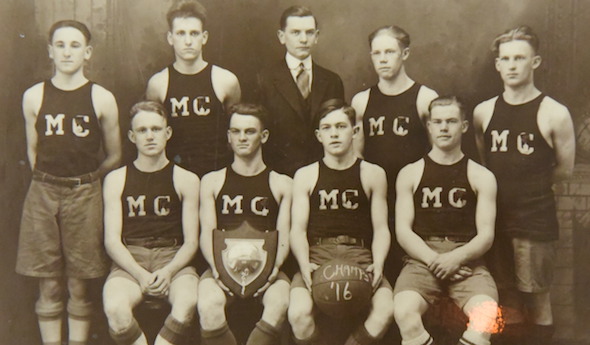
Michigan HS Hoops Celebrate a Century
February 27, 2016
By Ron Pesch
Special for Second Half
Today we know the campus, and the buildings and playing fields it contains, as Eastern Michigan University. But 100 years ago, the grounds were known as Michigan State Normal College.
On an unusually warm 2016 February day, down on the court of Eastern’s Convocation Center, the Eagles of Eastern and the University of Toledo Rockets warmed up for tip-off. Standing near the doorway of a suite, above the action, Chris Ming, athletic director at Marine City High School, showed off an oak plaque, adorned with a beautiful silver shield featuring a basketball design in relief.
“I can tell you, they don’t make them like this anymore,” Ming said.
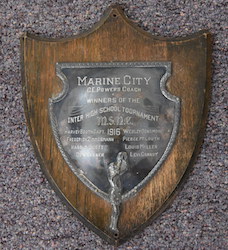 At halftime, Ming and five other representatives from Michigan high schools met at center court to celebrate an event that had occurred a century ago on this campus. In March 1916, around 100 students total representing 12 high schools traveled to Ypsilanti to participate in what has been billed as the first organized high school basketball tournament in Michigan.
At halftime, Ming and five other representatives from Michigan high schools met at center court to celebrate an event that had occurred a century ago on this campus. In March 1916, around 100 students total representing 12 high schools traveled to Ypsilanti to participate in what has been billed as the first organized high school basketball tournament in Michigan.
Historically speaking, the college was a perfect location for that tournament.
“In 1894 the Michigan State Normal College in Ypsilanti had started a new major in physical education. (Professor) Wilber Bowen was appointed chairman of that program,” wrote Dr. Erik (Rick) Pedersen, Professor Emeritus from EMU’s School of Health Promotion & Human Performance in a 2006 article for the Ypsilanti Historical Society. “Bowen had met James Naismith (who developed the game of basketball in 1891 at Springfield College in Massachusetts) through their involvement with the American Association for the Advancement of Physical Education in the late 1880's and early 1890's. To meet the needs of a new major program, the college had also completed construction of a new gymnasium in April of 1894. Bowen was looking for ideas to help with the dedication ceremony of the new gymnasium and recognition of the new major program. Consequently, arrangements were made to have the first basketball game played west of the Allegheny Mountains on May 18th, 1894, in Ypsilanti, Michigan.”
According to newspaper articles covering the 1916 high school tournament, the goal of the event was to arouse “greater interest in basketball in the smaller schools.” Around 300 invitations were sent out to high schools across the state having enrollments of “less than 200 students to take part in a basketball tournament.” It was through the efforts of the college’s Men’s Union, with cooperation from the Athletic Department, that the tournament was organized. According to the 1916 Michigan State Normal College yearbook, Aurora, the tournament also had a second goal. Acting in the best interests of the college, the Men’s Union wanted to showcase the “advantages offered at the Normal” in hopes of attracting future enrollment.
Enrollment at the time was fewer than 2,000 students. The college was the nation’s first teacher-training school to offer a four-year degree, and enrollment was dominated by females. The Men’s Union was formed in 1914 with the stated goal of bringing the male student body together socially, and to work toward recruiting more men to the college.
“Expenses related to transportation, room, and board (for the tournament) had to be provided by the participating schools,” noted Pedersen prior to the 2016 centennial gathering. “The Michigan State Normal College's Physical Education Department made it easier for schools to participate by making arrangements with local residents to provide food at 20 to 25 cents a meal and lodging at 25 cents a night for each player.”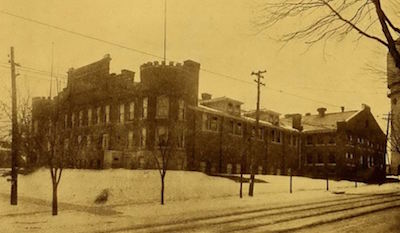 As things fell into place in Ypsilanti, awards were purchased, and prior to the contests, the trophies were placed on display at The Rowima Company, a general store near the school, to help build excitement for the games. It was also announced that players of the winning team would receive individual medals.
As things fell into place in Ypsilanti, awards were purchased, and prior to the contests, the trophies were placed on display at The Rowima Company, a general store near the school, to help build excitement for the games. It was also announced that players of the winning team would receive individual medals.
“The event is the first of its kind in the state and will be made an annual affair,” it was stated in the Daily Ypsilantian Press prior to the start of the tournament. “It is the aim to have larger high schools included in the contest if the affair is a success and as interest develops a more extensive list of prizes will be arranged. A small admission will be charged for each session which will include three or four games.”
Spread over three days, March 23 – March 25, sessions were scheduled for 7:30 on Thursday evening, 9:30 a.m., 1:30 p.m. and 7:30 p.m. on Friday, and Saturday at 9 in the morning and 1:30 in the afternoon at the Normal college gymnasium.
By Saturday afternoon, Dundee and Marine City had emerged as the tournament’s top teams, with 5-1 records, forcing a title game.
“Half the town turned out Saturday night to welcome the victorious basketball team home from Ypsilanti,” wrote a reporter for the Port Huron Times-Herald following Marine City’s thrilling 23-22 victory in the title game. “The silver shield, a trophy of the state championship, was proudly displayed by Coach Powers and every boy was glad to show his own individual (silver) medal.”
With a second-place finish, Dundee was awarded a handsome silver cup, while Milan, Mancelona and Farmington each received a banner in the Normal school colors of green and white, signifying a three-way tie in the tournament for third. Teams from East Lansing, Elkton, Middleville, Mount Clemens, Royal Oak, Saline, and Wayne also competed in the event. Teams were eliminated from play after two losses.
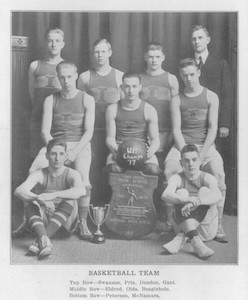 “… It was a great day for Marine City when her team won,” continued the Times-Herald article. “Each member of the high school can take credit for the victory as the money to defray the expenses of the clash was earned in a series of inter-class games played during the last two weeks.”
“… It was a great day for Marine City when her team won,” continued the Times-Herald article. “Each member of the high school can take credit for the victory as the money to defray the expenses of the clash was earned in a series of inter-class games played during the last two weeks.”
Conversations about the use of tournaments to identify a state basketball champion in Michigan had been kicked around in years past.
“As long as teams journey about the state taking on different teams, making a fairly good showing and then trying to win titles by arguments based on comparative scores, all that will result in argument and three or four champions,” stated coach Edbert C. Buss of Detroit Central High School in a 1914 article in the Jackson Citizen Patriot. “The only way I can see to settle the title on the proper team and make it undisputed is by dividing the state into three sections, an eastern, western, and northern district.”
After determining district champions, Buss suggested then a state tournament at a central location to identify a true state champion.
Teams in the Upper Peninsula of Michigan staged basketball tournaments as early as 1913, with Ishpeming claiming the U.P. crown that winter.
“Calumet claims an Upper Peninsula title for 1914,” said Robert Erkkila, a U.P. historian from the city. “We’ve never claimed it to be a state championship.” Yearbooks attest to the fact, indicating they beat Ishpeming 24-21 in the U.P. tournament hosted at the Ishpeming YMCA. “While (Notre Dame legend) George Gipp didn’t spend a lot of time in high school, and never played on Calumet’s football team, he did play basketball, and was on that team,” stated Erkkila.
In January 1917, Northern Michigan Normal College (today, Northern Michigan University) announced plans for the very first U.P. tournament, scheduled for March 2 in Marquette. Michigan State Normal College hosted their second annual tournament, beginning on March 15th, while the University of Michigan and the Michigan College of the Mines in Houghton (known these days as Michigan Tech) scheduled tournaments for the following week.
Again, 12 teams entered the Michigan State Normal College tournament, which still targeted schools with high school enrollment of 200 of fewer.
“Four games of basketball will be played at one time in the state normal gymnasium,” wrote a Flint Journal correspondent, describing Mount Morris’ planned visit to the Normal tournament. “While on this trip the boys will visit the University of Michigan and will do some sight-seeing in Detroit on the trip home.”
“The visiting teams were so well-treated and the tournament was such a success that this year not enough rooms could be found to provide for the teams, and so the offices of the Gym were turned into a veritable dormitory,” recalled the 1917 Normal annual, Aurora.
“The games were all played in quarters with a minute rest between quarters and ten minutes rest between halves,” added the Journal correspondent following the tournament. “The (Mount Morris) boys were accorded a splendid time, given free use of the swimming pool, shower baths and were treated to a banquet in the gymnasium hall by members of the faculty of the State Normal College Friday evening.”
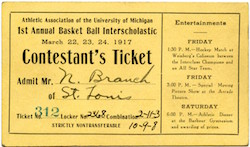 Grayling emerged as the winner of the Normal tournament, winning four games over the two-day gathering. With a 49-9 win over Chelsea, the team earned a silver cup, while team members each earned medals. With confidence, the team stayed over, rested for a few days, then entered the U-M tournament, which was open to all schools of the state.
Grayling emerged as the winner of the Normal tournament, winning four games over the two-day gathering. With a 49-9 win over Chelsea, the team earned a silver cup, while team members each earned medals. With confidence, the team stayed over, rested for a few days, then entered the U-M tournament, which was open to all schools of the state.
The interscholastic department of University of Michigan sent out around 250 printed circulars throughout the state, inviting teams to the “first annual inter-scholastic basketball tournament,” according to a January 5, 1917, article in the Flint Journal.
“Michigan’s first interscholastic basketball tournament is to be held in Waterman Gymnasium on March 22, 23 and 24, and replies from high schools of the State indicate that more than fifty quintets will battle through an elimination series for the State High school championship,” stated the February 1917 edition of The Michigan Alumnus. “This is the first time the University Athletic Association has attempted such a tournament and in view of the fact that Michigan is to have a Varsity basketball five next winter, the inauguration of the high school tourney this year becomes especially important.”
A recent enlargement of Waterman made the tournament possible. With four available courts, it was felt that the tournament could handle more than 60 teams and still be run in three days.
In total, the final field totaled 39 teams from 38 schools including squads from both peninsulas. Detroit Northwestern entered two teams, both coached by Bert Maris. The field was broken into four divisions.
“The meet is expected to result in a more satisfactory settlement of the scholastic championship than has been possible heretofore and to interest promising high school athletes in the University,” noted the March edition of the Alumnus.
The Michigan fraternities hosted the high school players during their stay with “a variety of entertainment … prepared to fill the odd hours,” including a hockey game at Weinberg Coliseum and a moving picture show at the Arcade Theater on Friday. A big dinner was planned for the final night of the tournament at the Barbour gymnasium, “at which the various cups and medals will be awarded,” according to the Alumnus. “The high school men were given the chance to get acquainted with University life and Michigan life in particular.”
“Three hundred high school players and coaches descended on the campus, and in a scene of mass confusion, 17 games were played on the first day alone,” wrote the late Dick Kishpaugh, historian for the MHSAA for 50 years. “Eventually, Detroit Northwestern, coached by Bert Maris, defeated Jackson, 24-21, to capture what virtually all observers at the time recognized as the first true state boys’ basketball champion.”
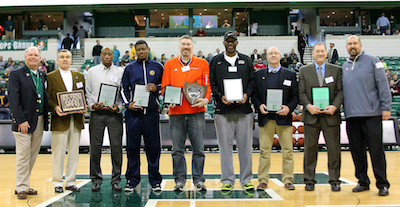 In 1918, the Michigan State Normal tournament marched on for a third year, with 16 teams participating. The title was won by Milan, with Grayling finishing second. World War I halted the University of Michigan’s plan to repeat the format of 1917. However, the desire to find a champion among the state’s larger schools saw the state’s top teams, Kalamazoo Central and Detroit Central, travel to Ann Arbor for a special one-game championship contest. The teams had split two previous meetings that year. The rubber match, and hence the title, was won by Kalamazoo 26-18.
In 1918, the Michigan State Normal tournament marched on for a third year, with 16 teams participating. The title was won by Milan, with Grayling finishing second. World War I halted the University of Michigan’s plan to repeat the format of 1917. However, the desire to find a champion among the state’s larger schools saw the state’s top teams, Kalamazoo Central and Detroit Central, travel to Ann Arbor for a special one-game championship contest. The teams had split two previous meetings that year. The rubber match, and hence the title, was won by Kalamazoo 26-18.
“Just who was in charge of the tournaments was the subject of heated debates in the early years,” Kishpaugh added. “High school administrators and the University of Michigan shared the responsibility in 1917 and 1918, but then (Michigan Agricultural College) wanted a piece of the action, and the finals were moved to East Lansing in 1919.”
That year, competition was divided into two, Class A for the larger schools and Class B for the smaller ones, setting a precedent for class competition which has been the hallmark of Michigan tournaments ever since.
In 1920, the predecessor to the MHSAA, a group called the Michigan Interscholastic Athletic Association, headed by high school administrators, took control of prep athletics and the tournament. Among their first actions was to split the finals between Ann Arbor and East Lansing each year. That year, Class A championship games were played at U-M in Ann Arbor, while Class B games were hosted at M.A.C. in East Lansing. Sites were reversed in 1921. The addition of Class C, segmenting the tournament further, came in 1922, and those games were played in the same city as Class B. The pattern was followed until 1926.
When the present Michigan High School Athletic Association was formed in the fall of 1924, Alden W. (Tommy) Thompson was hired on a full-time basis as State Director of the sport. Every tournament since 1925 has been under the direction of the MHSAA. In 1926, Class D was added, forming the approach taken to naming basketball champions in Michigan that we still use today.
 Ron Pesch has taken an active role in researching the history of MHSAA events since 1985 and began writing for MHSAA Finals programs in 1986, adding additional features and "flashbacks" in 1992. He inherited the title of MHSAA historian from the late Dick Kishpaugh following the 1993-94 school year, and resides in Muskegon. Contact him at [email protected] with ideas for historical articles.
Ron Pesch has taken an active role in researching the history of MHSAA events since 1985 and began writing for MHSAA Finals programs in 1986, adding additional features and "flashbacks" in 1992. He inherited the title of MHSAA historian from the late Dick Kishpaugh following the 1993-94 school year, and resides in Muskegon. Contact him at [email protected] with ideas for historical articles.
PHOTOS: (1) The Marine City boys basketball team won the inaugural high school basketball tournament at Michigan State Normal College. (2) A plaque commemorating the achievement hangs at the school. (3) The gymnasium at what is now Eastern Michigan University hosted the event. (4) Ishpeming won the first basketball tournament played in the Upper Peninsula. (5) University of Michigan hosted a tournament for schools of all enrollments in 1917. (6) Representatives of schools that played in the 1916 tournament at Michigan State Normal College receive plaques during a game this season at EMU. (Top five photos collected by Ron Pesch; bottom photo by Jonathan Knight.)
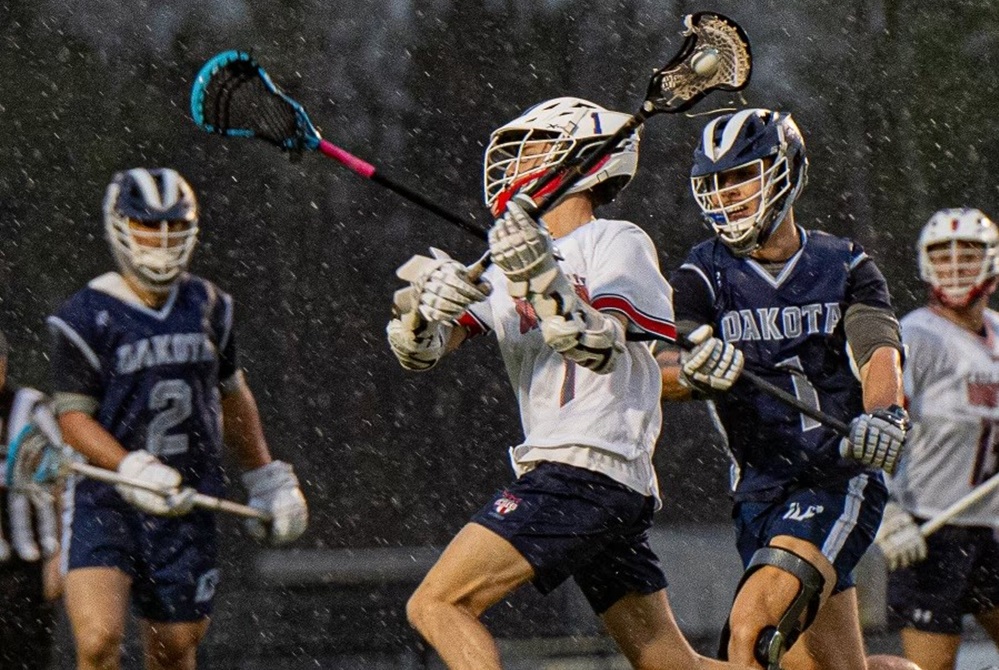
Future Has Arrived as Port Huron United Continues Impressive Climb
By
Paul Costanzo
Special for MHSAA.com
May 8, 2024
Brad McDougal knew when he returned to the Port Huron United lacrosse program in 2019 that in order to grow it to what he thought it could be, he’d have to build for the future.
 His plan was simple and time-tested: Start a youth program that would get players within the school system playing together more frequently and against better competition, preparing them to one day be varsity players.
His plan was simple and time-tested: Start a youth program that would get players within the school system playing together more frequently and against better competition, preparing them to one day be varsity players.
It didn’t take long to see that it could work, and perhaps better and faster than he had hoped.
“We’ve known for a while (this was the year),” McDougal said. “Basically, when I started with that youth team, my ambition was if I can get four or five kids that have been coached, then build around them for the varsity program, that would be great. It turned out to be 15 of them.”
Behind 15 seniors, the majority of whom were part of McDougal’s original youth team, Port Huron United is competing at a level it never has before. United is ranked No. 9 in the Division 1 MPR following a 10-3 start, and won the Macomb Area Conference Red title for the first time in program history.
It’s a history that McDougal is plenty familiar with, having been a high school junior when the program began in 2006. McDougals have been part of the program ever since, whether it was him as a coach fresh out of high school and now, his brother Ben as a player, or his father Brian as a coach at various levels throughout all of it.
“Being around it as long as I have, that has sunk in,” he said. “The amount of teams that are reaching out to us now that never would have before – teams reaching out for film, ‘How were you able to defend this?’ Teams reaching out for scheduling that I think would have just ignored the email a couple years back. It’s definitely not lost on me.”
It’s also not lost on the players, who have heard McDougal talk about the program’s beginnings and have also seen first-hand a quick ascent.
As freshmen, this current group of seniors were a major part of a varsity team that played in the MAC Blue – the MAC’s divisions are based on performance, with Red being the highest – dominating it and earning promotion to the MAC White the following season. Another unbeaten league season put United into the MAC Red in 2023, and while there were some growing pains in going 2-3 against higher-level competition, there were signs of better things to come.
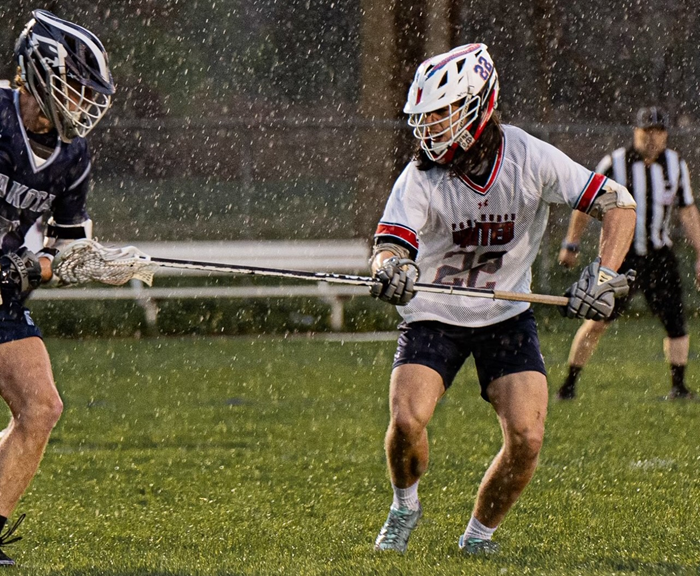 “The second my class joined, we just dominated our leagues,” senior goalie Danny Moore said. “We went from Blue to White to Red in three years. Last year in the Red, we went 2-3, but it wasn’t without close games. I think (the rise) definitely stunned us a little bit. Not a week goes by that I don’t think about the giant leap we took. It’s like a world record long jump.”
“The second my class joined, we just dominated our leagues,” senior goalie Danny Moore said. “We went from Blue to White to Red in three years. Last year in the Red, we went 2-3, but it wasn’t without close games. I think (the rise) definitely stunned us a little bit. Not a week goes by that I don’t think about the giant leap we took. It’s like a world record long jump.”
Moore said the team started this season “like a cannonball out of the cannon with too much gun powder” as this group of seniors knew it was their last opportunity to play with one another.
United was dominant in its MAC Red season, going 5-0 and out-scoring opponents 61-12, not allowing more than three goals in any single game.
On the season, it has outscored opponents 136-50, led by senior goal-scoring threats Silas Klink, Jacob O’Hare, Nate DeLand, Matt Graham and Tim Monaghan. Moore is stopping more than 80 percent of the shots he’s faced, behind the defense of seniors Jack Bennett and Max Williams, and junior Parker Quinn, among others.
That’s despite a beefed-up nonconference schedule, which McDougal put together to better prepare his team for the upcoming postseason.
“We have a way harder schedule this year,” Klink said. “We haven’t ever made it to the Regional Final in all the program’s history, so that’s a big goal. I think scheduling all these teams, Coach McDougal knew what he was doing to get us battle-tested.”
Boys Lacrosse Regionals open May 16, and Lake Orion – which defeated Port Huron 11-4 in the season opener – is the host of United’s bracket.
Winning a Regional is the next goal for Port Huron, and McDougal repeatedly tells his team he wants a Michigan trophy. They’re ready to do all they can to make that happen, but also aren’t shying away from the possibility of blowing away his expectations once again.
“State champs,” said Bennett, who has committed to play lacrosse at Albion College along with Moore. “We want to go all the way. It would just be like – I don’t even know how to describe it. For the program, it would further push lacrosse at my high school and Port Huron. Twenty years ago, we didn’t even have a lacrosse team, so I think it would really push lacrosse in Port Huron.”
 Paul Costanzo served as a sportswriter at The Port Huron Times Herald from 2006-15, including three years as lead sportswriter, and prior to that as sports editor at the Hillsdale Daily News from 2005-06. He can be reached at [email protected] with story ideas for Genesee, Lapeer, St. Clair, Sanilac, Huron, Tuscola, Saginaw, Bay, Arenac, Midland and Gladwin counties.
Paul Costanzo served as a sportswriter at The Port Huron Times Herald from 2006-15, including three years as lead sportswriter, and prior to that as sports editor at the Hillsdale Daily News from 2005-06. He can be reached at [email protected] with story ideas for Genesee, Lapeer, St. Clair, Sanilac, Huron, Tuscola, Saginaw, Bay, Arenac, Midland and Gladwin counties.
PHOTOS (Top) Port Huron United’s Silas Klink (1) makes a run at the goal against Macomb Dakota. (Middle) Matt Graham (12) maintains possession against the Cougars. (Photos by Margaret Quinn.)

